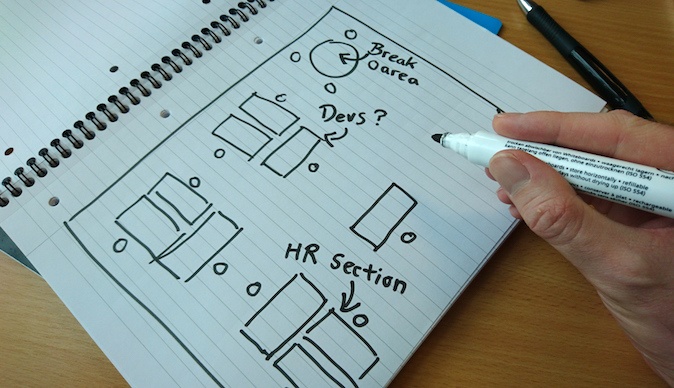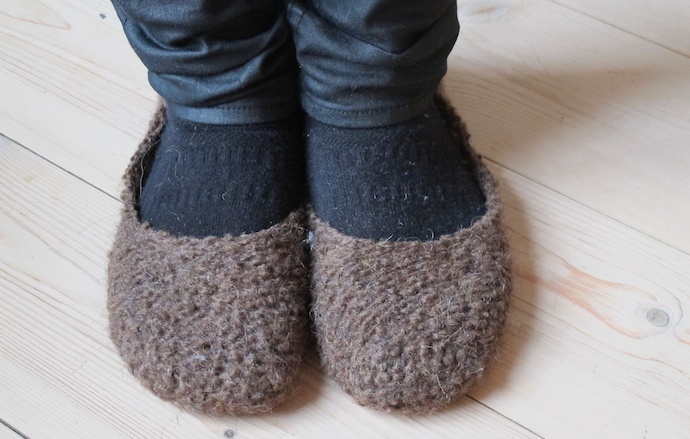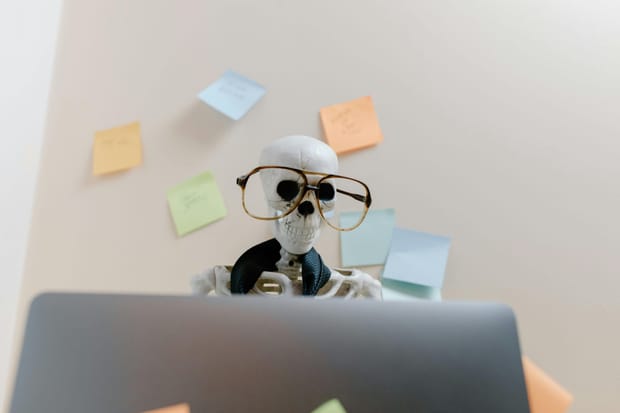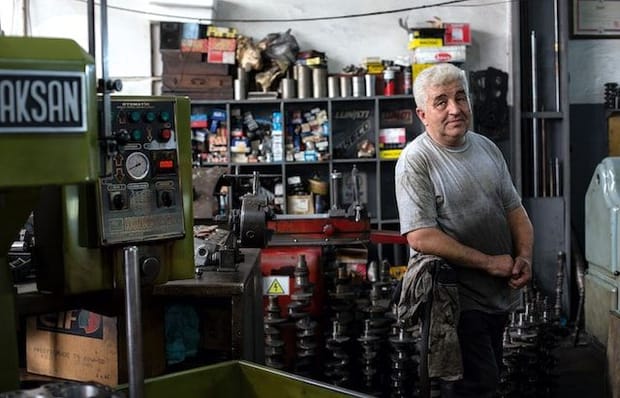High levels of staff turnover can be crippling for any business, with research suggesting that it costs more than £30k to replace a single employee.
It definitely pays to keep your people happy, but how, aside from rolling out a long list of workplace perks, can you do that?
One way to make life better for your employees is to focus on creating an office environment that's genuinely pleasant to work in.
There are plenty of minor tweaks that you can make to your workplace in order to increase wellbeing and productivity — and the great news is that they cost a fraction of what you'd spend recruiting, interviewing and training replacement staff.
Join us as we discuss ten simple (but potentially business-changing) office hacks that will improve your workplace and encourage staff to stick around.
1. Change your layout

Space may be a concern, but where and how you seat your staff matters. There's no need to be all fengshui about the placement of your desks, but there are a number of factors that you should consider:
- Do your staff have enough privacy? It can be difficult to focus when you're seated on the office thoroughfare or with your screen visible by the entire team. Ask yourself whether you'd be happy to work at every desk in your office. If the answer is no, then you shouldn't ask an employee to do so.
- Does the layout facilitate healthy communication? Staff whose roles relate to one another should always be seated close by. This will remove the need for them to be constantly visiting one another's desks or holding conversations over others' heads. Also, leave plenty of room between desks so that it's easy for staff to navigate the office and speak to other teams.
- Is the entire office well lit? Are any of your staff seated far from the windows? Could they benefit from a desk lamp or an uplighter? Conversely, if your office gets a lot of direct sunlight, you should ensure that those seated next to the windows have blinds they can close if they get too hot or if the sun's glare obscures their monitors.
- Does your office have any draughts or cold spots? A common problem during the winter months is that staff whose desks are close to the door have to put up with blasts of cold air whenever someone enters the room. If you must seat an employee next to a door, invest in a couple of partition screens to keep the cold air off them.
Consider using desk clusters, inward-facing rows, or even L-shaped desks to create a space that feels less regimented than the typical office environment. Try to involve your staff in this process if you can — the office is where they'll spend most of their waking hours from Monday to Friday, after all, so they'll appreciate having a say in where they sit!
2. Play music

Too much noise in the office can make it difficult for employees to focus, but overly quiet rooms can make them reluctant to speak at all.
Consider piping in some music (played at a reasonable volume) for your staff to listen to while they work. As well as being good for productivity, music allows staff to discuss sensitive subjects without feeling like the entire office is listening. Plus, gentle music can help drown out the kind of everyday sounds that people working in close proximity find irritating — the constant creak of a coworker’s chair, for example, or someone slurping their tea...
When it comes to choosing the type of music to play, think about the kind of work your staff do. There's evidence to suggest that different genres of music have different effects on people, helping them concentrate, work faster, or even come up with new ideas, so experiment with your tunes to find the right vibe.
Finally, try to avoid using an employee's computer as the office jukebox. This could make it difficult for them to concentrate, and they may end up spending more time DJ-ing than actually working.
Here at RotaCloud, we use a Sonos wireless speaker, kept in a far corner of the room, streaming a mix of pop, soundtrack and rock. It has its occasional hiccups, but most of the time it works well.
3. Let staff use earphones

It might seem strange to recommend playing music in the office and allowing staff to listen to their own, but there are plenty of good reasons why you should consider doing so.
There will inevitably be times when the music you're playing isn't 100% right for the entire team. Those writing or editing copy, for example, might find it difficult to focus when listening to music that contains lyrics, and those with deadlines approaching might appreciate something a little more upbeat.
It's at times like these when headphones are the office worker's best friend.
Some office managers forbid the use of headphones entirely, arguing that they make it difficult for their colleagues to communicate with them. Others allow their staff to use earbuds, provided that they keep one ear free at all times or set the volume of their music to low.
It's up to you how you want to govern the use of personal headphones in your office, but don't be too quick to ban them outright — staff appreciate being able to tailor their working environment, and if listening to their own music helps a member of your team get their work done faster, surely it's worth the inconvenience of not being able to talk to them from across the room?
4. Encourage workspace personalisation

You might want to draw the line at your employees hooking games consoles up to their monitors or bringing in mini fridges, but allowing staff to customise their workspaces is a free and easy way to boost morale.
Family photos, personal mugs, even stress toys like the fidget cube pictured above can help your staff feel at home. These things also make great conversation starters and allow the members of your team to see another side to their coworkers, often leading to closer working relationships.
'Hot-desking', wherein staff use whatever workspace is available on the day, can be effective when your team works shifts or follow a rota. Generally speaking, though, most staff are happier sitting in the same spot every day, so encourage them to make it their own.
5. Get some plants

When you're stuck indoors all day, the mere presence of a few houseplants can make a huge difference.
Brighten up your office by strategically positioning some low-maintenance foliage around the room and encouraging your staff to look after them.
The simple act of tending for a plant has been found to increase happiness levels in employees, and can even make them more productive in their jobs. But there are a number of additional benefits to having plants in the office, including:
- Cleaner air, with fewer allergens
- Reduced stress levels
- Increased humidity (great for offices with air conditioning)
- Lower noise levels, especially in rooms with hard floors
- Can be easily converted into Christmas trees
Okay, that last one might just be us, but plants are a must-have for any modern office environment — just be sure to choose ones that can be easily looked after and don't require enormous amounts of sunlight.
6. Watch that thermostat

Room temperature can have an enormous effect on productivity, even when you ignore the squabbles that famously flare up over the office thermostat.
The problem is simply that some people feel the cold more than others, whereas others start to melt the moment the sun comes out.
A room temperature of 18-21 degrees Celsius is generally considered to be ideal for desk work, but the key to keeping your staff happy during the winter and summer months is to allow them to make themselves as warm or cool as they prefer.
Rather than forcing everyone in your office to agree on a temperature, provide those who want them with room fans in the summer and portable oil heaters and lap blankets in the winter (the latter might seem a bit old-school, but they're very popular in offices in Asia). This will cut down on disagreements over the number on the thermostat, and may also help your staff avoid catching colds or falling victim to summer fatigue.
7. Set up a dining area

When you spend your entire day at a desk, it can be tempting to eat your lunch there too, browsing your Facebook news feed while nibbling on a sandwich or pasta salad.
While this may be an easy way to get the most out of our limited break times, eating at our desks is tremendously bad for us. Here's why:
- According to the British Heart Foundation, adults of working age in England now spend more of their day sitting down than ever. By eating at their desks, staff not only miss out on the chance to interact with coworkers, but one of the few opportunities to move around, putting their health at risk.
- Evidence suggests that remaining at our desks all day actually makes us less productive. Taking frequent breaks makes us feel more alert and helps us focus on our work when we return to it.
- The average computer keyboard is home to millions of bacteria — by eating at their desks, your employees are basically setting themselves up to get sick. Plus, bits of food always find their way into the gaps between the keys and onto the floor, which can encourage pests and vermin.
The solution? Even if you don't have a kitchen in your office, be sure to set up a place for small groups of people to sit and eat together.
A couple of tables and chairs is all it takes to encourage your staff to move away from their screens for lunch. The change of scenery will help them feel refreshed, and they'll get to know their coworkers better by taking breaks in a shared area.
8. Set up a private space

This is especially important if you have an open-plan office.
Even if you generally like to encourage group participation and the free exchange of ideas, there will come a time when members of your team will want to discuss something quietly or need a place to think.
If you don't have a separate meeting room, consider positioning a couple of simple couches (and maybe a coffee table) at the far end of the office and partially screen them off.
The space needn't just be used for meetings or chats about sensitive subjects either — providing a quiet spot with some soft furnishings encourages staff to adapt their thinking, and can result in them coming up with ideas that they might not have at their desk.
9. Let staff choose their chairs

When you spend most of your day on your bottom, it's important to have a chair that's both comfortable and supportive.
But instead of trying to find one kind of chair that suits everyone in your office, why not give your staff a few models (with and without armrests or head supports, for example) to choose from?
There's no need to hand new recruits a chair catalogue and a blank order form, but having a few different models to try out will ensure that they get the chair that's right for them.
Plus, with their very own chairs adjusted how they like them, your staff will be more inclined to think about their posture when sitting — and thus less likely to suffer from back and neck pain as a result.
10. Go 'slipperati' in the office

You have wonder why, when businesses spend millions of pounds every year on seating, wrist supports, monitor stands and air conditioning optimised for comfort, we in the UK find the idea of office employees wearing slippers so strange.
Leaving your outdoor shoes at the door has been the norm for decades, and in some cases, centuries, in numerous Asian and European countries. As well as being more hygienic and cutting down on the cost of cleaning, swapping outdoor for indoor shoes has a kind of transitioning effect on the wearer, making them feel more settled in their home or workplace.
Shoes, the thinking goes, are for transitioning between places, not spending time inside them.
It might seem a bit unusual at first, but there are a numerous potential benefits to joining the slipperati, including:
- Staff are more comfortable and able to focus on their work
- No more wet floors or dirty carpets
- No need to wear damp shoes all day after getting caught in the rain or snow
- Less back, leg and foot pain caused by wearing heels or ill-fitting shoes
For the sake of hygiene, you might want to draw the line at staff walking around in just their socks or barefoot, but inviting your staff to slip into some 'indoor' shoes once they arrive at work is a great way to help them settle in for the day.
Just be sure to get the whole office on board if you do try this out — there's no point in half of your team wearing fabric slippers if the rest are clomping around in wet or dirty shoes...
Final thoughts
Optimising your office needn't cost the earth, but taking the time to consider how your workspace will affect the daily lives of your employees could have a big impact on your business — and could even save you money in the long run.
Even if you've been settled in for a while, look for ways to make your employees feel at home, and keep an eye out for those minor annoyances that, while not something to complain about at first, can really add up over time.
With an office environment that's comfortable, customisable and conducive to work, your employees will be happier and more productive — not to mention less likely to call in sick or look for work elsewhere. Never be afraid to try something new and give your office a productivity makeover.
Enjoyed this article? Head to the RotaCloud Blog homepage for more tips, tricks and ways to expand your business.





